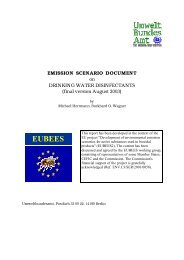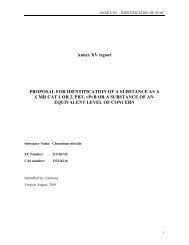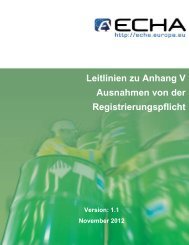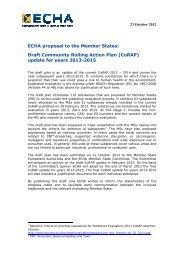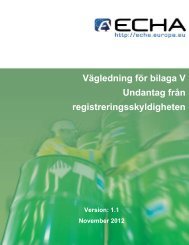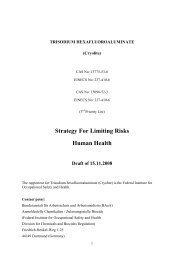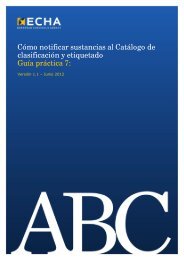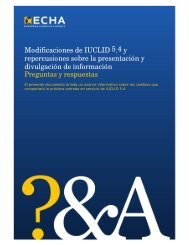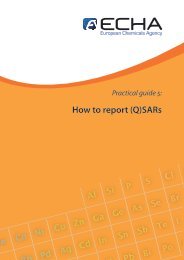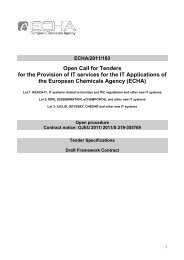Questions and answers on restrictions - ECHA - Europa
Questions and answers on restrictions - ECHA - Europa
Questions and answers on restrictions - ECHA - Europa
You also want an ePaper? Increase the reach of your titles
YUMPU automatically turns print PDFs into web optimized ePapers that Google loves.
the <strong>on</strong>ly substances that affect the refractive index of a soluti<strong>on</strong>. The potential for obtaining<br />
invalid results is therefore quite high <str<strong>on</strong>g>and</str<strong>on</strong>g> the method should therefore be used with<br />
c<strong>on</strong>siderable cauti<strong>on</strong>. It would therefore be advisable to recalibrate in case of doubt.<br />
The provisi<strong>on</strong> to c<strong>on</strong>trol the calibrati<strong>on</strong> of the PAH/PCA ratio every six m<strong>on</strong>ths is to safeguard<br />
the validity of the IP346 results against unintenti<strong>on</strong>al or unknown changes. This would apply<br />
for the case where the manufacturing process <str<strong>on</strong>g>and</str<strong>on</strong>g> materials used remain the same, <str<strong>on</strong>g>and</str<strong>on</strong>g> where<br />
there is no reas<strong>on</strong> be expect a change in the PAH/PCA ratio. However, it is possible to imagine,<br />
for example, that a tyre manufacturer receives a reformulated extender oil from his supplier<br />
without being made aware of the change that has been made, <str<strong>on</strong>g>and</str<strong>on</strong>g> the results from the IP346<br />
could be invalidated as a c<strong>on</strong>sequence. A six m<strong>on</strong>th recalibrati<strong>on</strong> interval was c<strong>on</strong>sidered<br />
sufficient to cover such occurrences.<br />
C<strong>on</strong>clusi<strong>on</strong>: The provisi<strong>on</strong> to c<strong>on</strong>trol the calibrati<strong>on</strong> of the PAH/PCA ratio after each “major<br />
operati<strong>on</strong>al change” is to safeguard the validity of the IP346 results. A major operati<strong>on</strong>al<br />
change is therefore a deliberate change to materials or processes that might be expected to<br />
significantly influence the PAH/PCA ratio, or otherwise affect the validity of the measurement.<br />
Examples of such a change would be where the source of supply for the extender oil is<br />
changed, or where the method of using the oil is changed.<br />
Judgment of whether a particular change is sufficiently important to trigger the need for<br />
recalibrati<strong>on</strong> will necessarily be made case-by-case <str<strong>on</strong>g>and</str<strong>on</strong>g> will require expert opini<strong>on</strong>.<br />
10.2 Tyres for mobile machinery<br />
Does the restricti<strong>on</strong>s provided in Entry 50 c<strong>on</strong>cerning <strong>on</strong> PAHs in tyres cover mobile<br />
machinery?<br />
Entry 50 to Annex XVII as enacted by Commissi<strong>on</strong> Regulati<strong>on</strong> 552/2009 restricts the use of<br />
PAH in tyres for "vehicles covered by Directive 2007/46/EC establishing a framework for the<br />
approval of motor vehicles <str<strong>on</strong>g>and</str<strong>on</strong>g> their trailers".<br />
Article 2 of Directive 2007/46 defines its scope. Paragraph 1 lists the vehicles designed for use<br />
<strong>on</strong> roads.<br />
Article 2 of Directive 2007/46, Paragraph 3 lists the following vehicles:<br />
a) vehicles designed <str<strong>on</strong>g>and</str<strong>on</strong>g> c<strong>on</strong>structed for use principally <strong>on</strong> c<strong>on</strong>structi<strong>on</strong> sites or in<br />
quarries, port or airport facilities;<br />
b) vehicles designed <str<strong>on</strong>g>and</str<strong>on</strong>g> c<strong>on</strong>structed for use by the armed services, civil defence, fire<br />
services <str<strong>on</strong>g>and</str<strong>on</strong>g> forces resp<strong>on</strong>sible for maintaining public order;<br />
c) mobile machinery.<br />
Article 2 of Directive 2007/46, paragraph 4 lists the following vehicles:<br />
a) vehicles intended exclusively for racing <strong>on</strong> roads;<br />
b) prototypes of vehicles used <strong>on</strong> the road under the resp<strong>on</strong>sibility of a manufacturer to<br />
perform a specific test programme provided they have been specifically.<br />
In additi<strong>on</strong> the definiti<strong>on</strong> of “motor vehicle” in point 11 of Article 3 requires that the vehicles<br />
covered should have a maximum design speed limit exceeding 25 km/h.<br />
In c<strong>on</strong>clusi<strong>on</strong> the restricti<strong>on</strong> in Entry 50 covers the tyres for vehicles listed in the Article 2<br />
paragraph 1, 3 <str<strong>on</strong>g>and</str<strong>on</strong>g> 4 of Directive 2007/46/EC which have a maximum design speed limit






